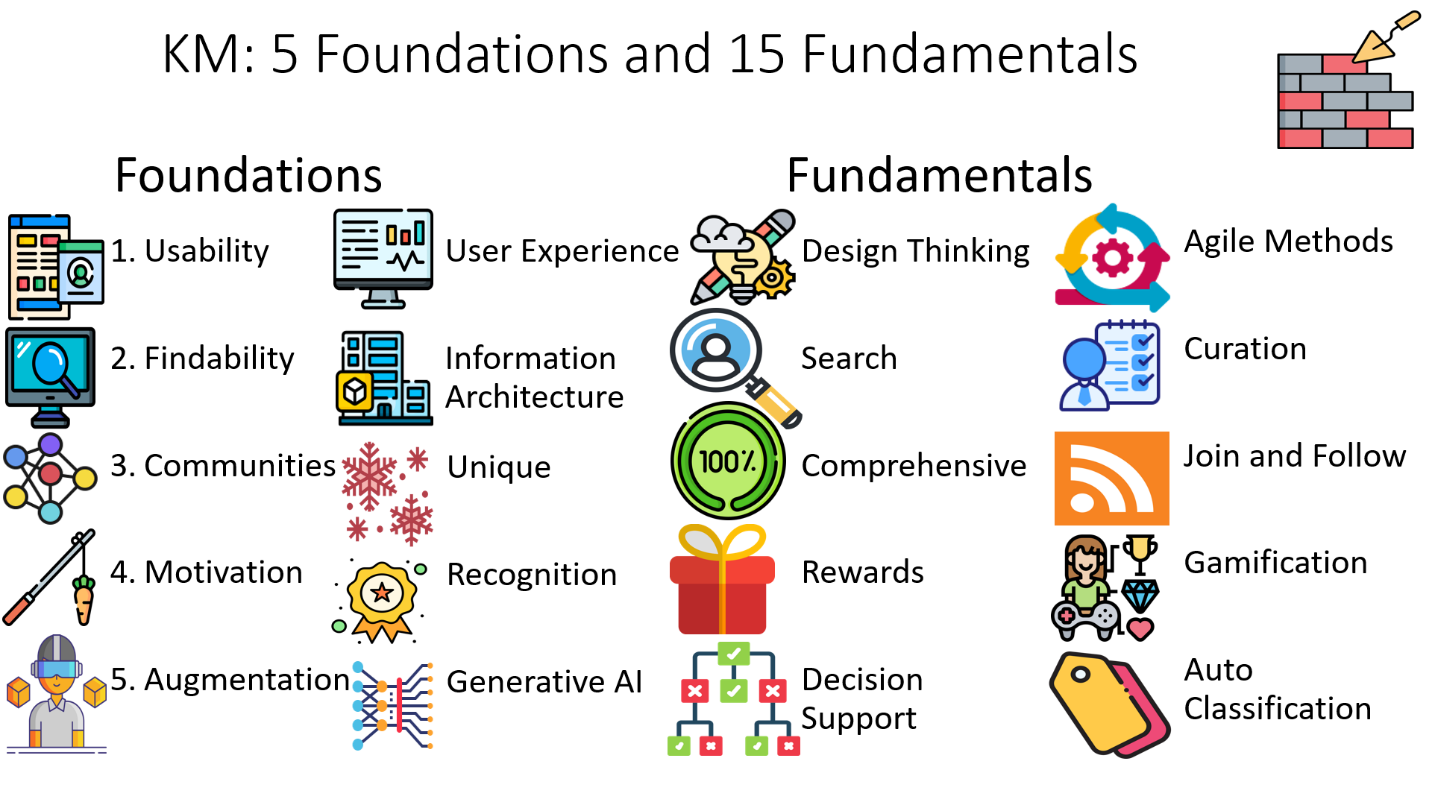Stan Garfield is a knowledge management author, speaker, and community leader. He led knowledge management and community programs at Deloitte, HP, Compaq, and Digital Equipment Corporation. He also worked for St. Louis University School of Medicine and Washington University School of Medicine. Stan holds a BS in Applied Mathematics and Computer Science from Washington University in St. Louis. He leads the SIKM Leaders Community (which he founded) with over 1,200 members globally and is invited to present at numerous conferences and webinars. Stan has published five books, contributed chapters to four more, and written over 900 blog posts and articles.

Knowledge management (KM) has been an established profession for over 30 years. It encompasses a wide range of elements – I have defined 50 components and 100 specialties. This breadth can make it overwhelming for both new and experienced practitioners. In this article, I recommend focusing on five foundational areas, each comprising three fundamental concepts. I include definitions and suggested approaches for applying them as part of knowledge management programs.
Foundation 1: Usability
Usability is making products and systems easier to use and matching them more closely to user needs and requirements. All KM tools that are developed or acquired should be designed and integrated to optimize user experience, using design thinking and agile development methods.
Fundamental 1: User Experience (UX) is a person’s perceptions and responses that result from the use or anticipated use of a product, system or service.
Fundamental 2: Design Thinking is a human-centered approach to innovation that draws from the designer’s toolkit to integrate the needs of people, the possibilities of technology, and the requirements for business success.
Fundamental 3: Agile Development is a way to manage a project by breaking it up into several phases. It involves constant collaboration with stakeholders and continuous improvement at every stage. Once the work begins, teams cycle through a process of planning, executing, and evaluating. Continuous collaboration is vital, both with team members and project stakeholders. It can be applied more broadly as Agile Management, which involves small teams and short cycles, is customer-driven, and works through a network, not a hierarchy.
Foundation 2: Findability
Findability is the ease with which information can be found, meaning that users can easily find content or information they assume is present on a website. Content should be structured using information architecture, it should be easily found using enterprise search, and it should be made readily available using curation.
Fundamental 4: Information Architecture is organizing, structuring, and labeling content in an effective and sustainable way to help users find information and complete tasks. It helps users understand where they are, what they’ve found, what’s around, and what to expect. It also enhances usability
Fundamental 5: Enterprise Search is making content from multiple enterprise-type sources, such as databases and intranets, searchable to a defined audience through a single, ubiquitous search engine.
Fundamental 6: Curation is collecting, selecting, assembling, and presenting information or multimedia content such as photos, videos, or music for other people to use or enjoy, using professional, expert, or personal knowledge and passion. Knowledge managers curate by taking existing information and making it more useful by better organizing it, making it more findable, and making it easier to use. Techniques for curating include creating search best bets, publishing frequently asked questions (FAQs), and compiling and sharing content and resources. Community managers curate by monitoring, tagging, and enhancing online discussions.
Foundation 3: Communities
Communities are groups of people who share an interest, a specialty, a role, a concern, a set of problems, or a passion for a specific topic. They deepen their understanding by interacting on an ongoing basis, asking and answering questions, sharing their knowledge, reusing good ideas, and solving problems for one another. A communities program should be a key component of any knowledge management program, providing exactly one community for each important subject. Everyone in the organization should be encouraged to join at least one community and pay attention to its threaded discussions.
Fundamental 7: Communities should be unique – only one for each topic. Redundant communities should be avoided. This allows a streamlined central directory of communities to be provided, helping potential members find the right ones to join. By keeping the number of communities to a reasonable minimum, a long and confusing list for users to choose from can be avoided. Having a single community for each subject avoids creating silos that isolate people who could benefit from being connected. And it allows critical mass to be achieved, helping to ensure that each community is active and takes advantage of scale.
Fundamental 8: A comprehensive set of communities should be provided – one for each important topic, role, and specialty in the organization. This ensures that there are no coverage gaps and that everyone can join a community relevant to them.
Fundamental 9: All organization members should be encouraged to join, subscribe to, and read the threaded discussions of at least one community, including the one most relevant to their work. All community members should receive email notifications or application alerts so that they can stay aware of new posts and replies, learn from the discussions, and respond helpfully whenever possible.
Foundation 4: Motivation
Motivation is the process that initiates, guides, and maintains goal-oriented behaviors. It is why a person does something, involving the biological, emotional, social, and cognitive forces that activate behavior. Knowledge management programs should include processes for recognizing and rewarding those who demonstrate desired behaviors, using gamification tools and techniques.
Fundamental 10: Recognition is thanks, likes, praise, publicity, and honors for performing desired behaviors.
Fundamental 11: Rewards are financial and tangible awards, including salary increases, promotions, bonuses, gifts, trips, and special opportunities.
Fundamental 12: Gamification is the application of typical elements of game playing to other areas of activity to encourage engagement with a process or tool. This includes point scoring, completion percentage indicators, and competitive rankings. It can also use digital badges, which are validated indicators of accomplishment, skill, quality, or interest that can be earned. Badges are a visual, short-term reward for completing an action, given to users for performing a certain number of actions of a given type.
Foundation 5: Augmentation
Augmentation is the process of increasing the value or quality of something by adding to it or making it greater. Artificial Intelligence (AI) provides the means to enhance human capabilities by augmenting their powers of observation, analysis, decision-making, processing, and responding to other people and to routine or challenging situations. Artificial intelligence should be incorporated into KM programs to provide decision support, automatically classify content, and take advantage of rapidly emerging generative AI capabilities.
Fundamental 13: Decision Support is compiling data from different areas and sources to provide information beyond the usual reports and summaries. It enables analyzing and comparing multiple alternatives to help make informed decisions.
Fundamental 14: Auto Classification is a methodology for scanning the contents of a document and automatically assigning tags, or descriptive labels and keywords, to that document. With the support of taxonomies and knowledge graphs, it indexes content into appropriate categories and classes to provide rich metadata that eases the content management process and enhances findability.
Fundamental 15: Generative AI consists of algorithms capable of generating seemingly new, realistic content from data they are trained on, including text, images, audio, software code, data, and 3D renderings. Generative AI models learn the patterns and structure of their input training data and then generate new data that has similar characteristics.






